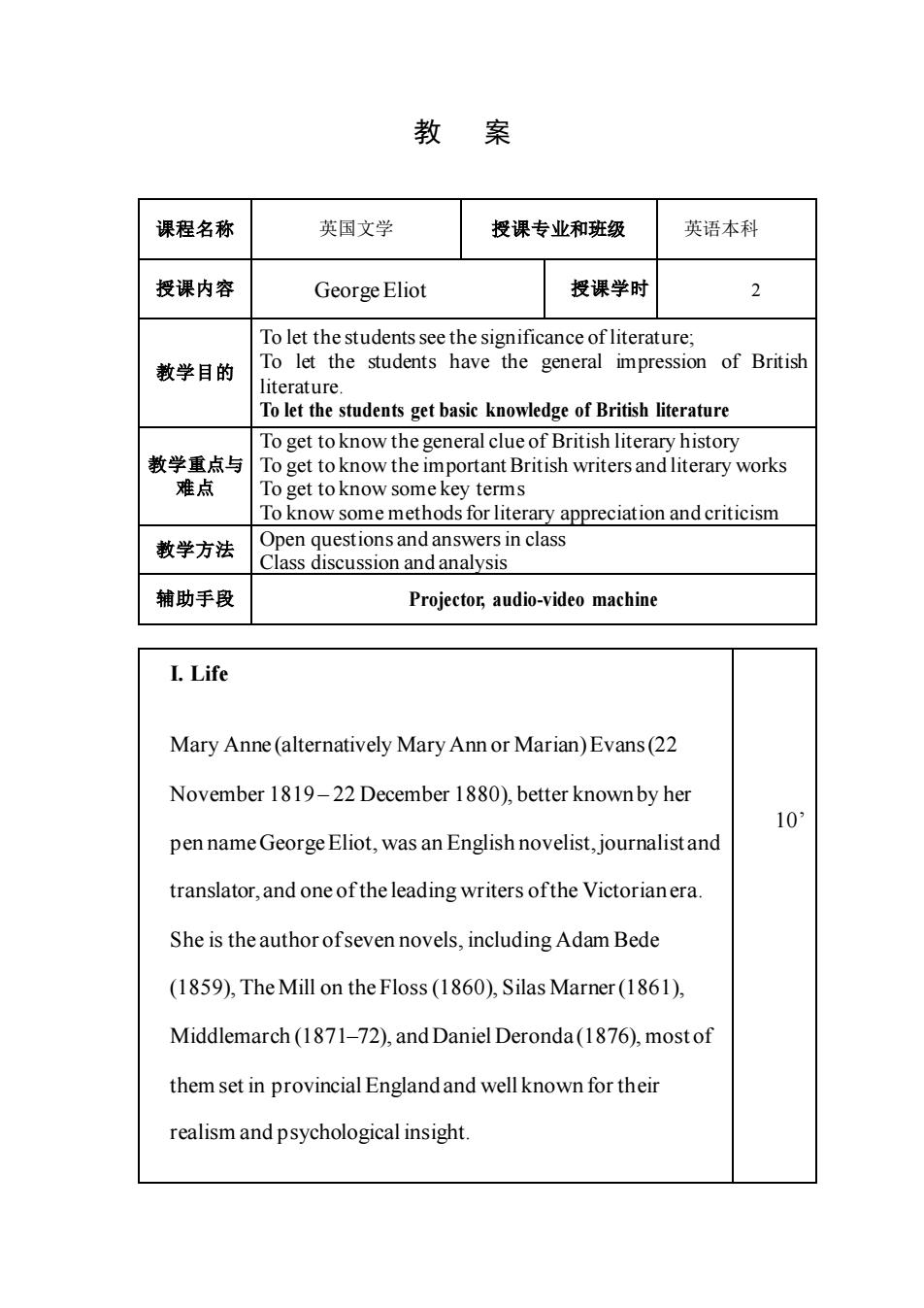
教案 课程名称 英国文学 授课专业和班级 英语本科 授课内容 George Eliot 授课学时 2 To let the students see the significance of literature; 教学目的 To let the students have the general impression of British literature. To let the students get basic knowledge of British literature To get to know the general clue of British literary history 教学重点与 To get to know the important British writers and literary works 难点 To get to know some key terms To know some methods for literary appreciation and criticism 教学方法 s in class 辅助手段 Projector,audio-video machine L.Life Mary Anne(alternatively Mary Ann or Marian)Evans(22 November 1819-22 December 1880),better knownby her 10: pen name George Eliot,was an English novelist,journalistand translator,and one ofthe leading writers ofthe Victorianera. She is the author ofseven novels,including Adam Bede (1859),The Mill on the Floss(1860),Silas Marner(1861), Middlemarch(1871-72),and Daniel Deronda(1876),mostof them set in provincial Englandand well known for their realism and psychological insight
教 案 课程名称 英国文学 授课专业和班级 英语本科 授课内容 George Eliot 授课学时 2 教学目的 To let the students see the significance of literature; To let the students have the general impression of British literature. To let the students get basic knowledge of British literature 教学重点与 难点 To get to know the general clue of British literary history To get to know the important British writers and literary works To get to know some key terms To know some methods for literary appreciation and criticism 教学方法 Open questions and answers in class Class discussion and analysis 辅助手段 Projector, audio-video machine I. Life Mary Anne (alternatively Mary Ann or Marian) Evans (22 November 1819 – 22 December 1880), better known by her pen name George Eliot, was an English novelist, journalist and translator, and one of the leading writers of the Victorian era. She is the author of seven novels, including Adam Bede (1859), The Mill on the Floss (1860), Silas Marner(1861), Middlemarch (1871–72), and Daniel Deronda (1876), most of them set in provincial England and well known for their realism and psychological insight. 10’
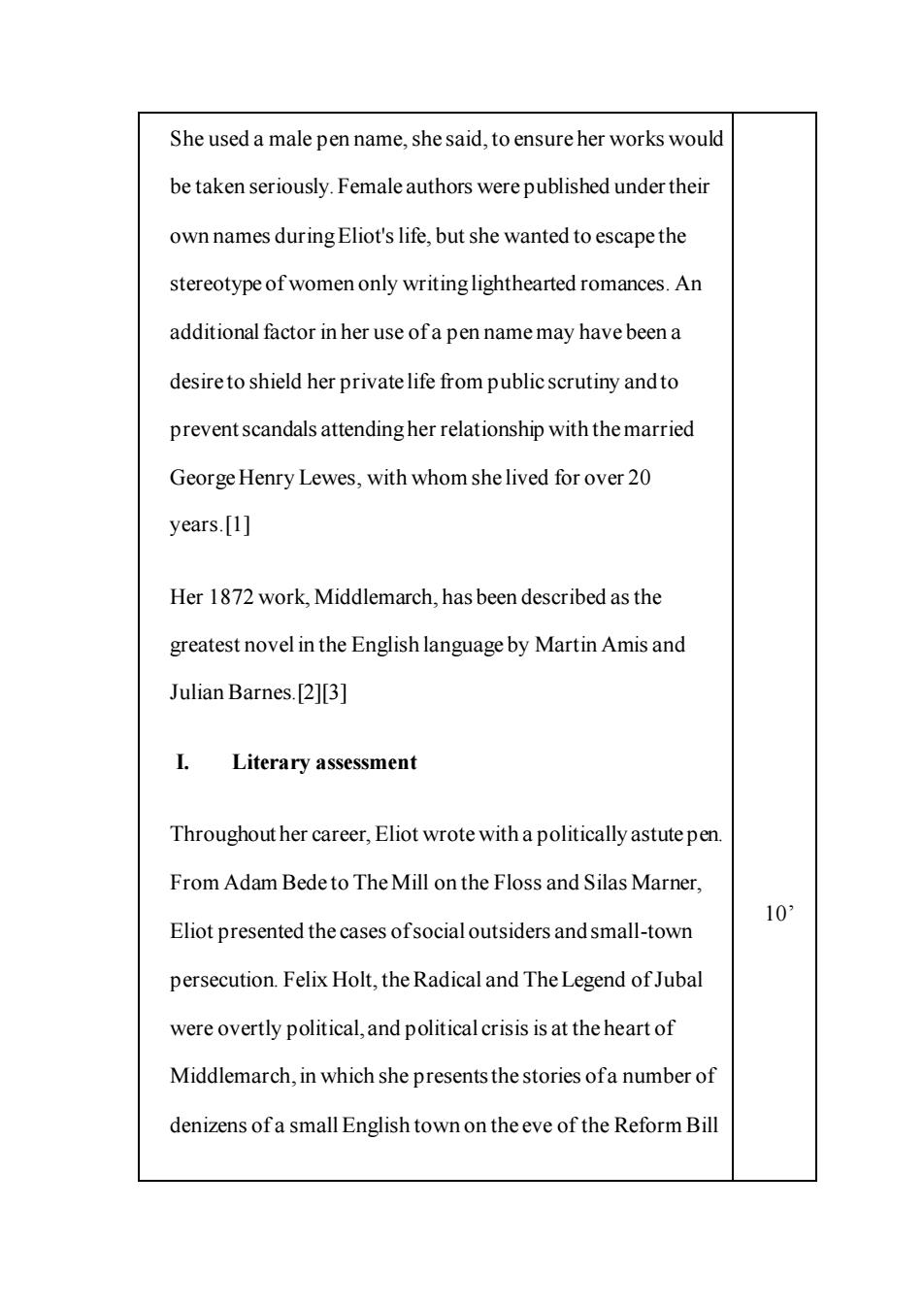
She used a male pen name,she said,to ensure her works would be taken seriously.Female authors were published under their own names during Eliot's life,but she wanted to escape the stereotype of women only writinglighthearted romances.An additional factor in her use ofa pen name may have been a desireto shield her private life from public scrutiny andto prevent scandals attending her relationship with the married George Henry Lewes,with whom she lived for over 20 years.[1] Her 1872 work,Middlemarch,has been described as the greatest novel in the English language by Martin Amis and Julian Barnes.[2][3] Literary assessment Throughout her career,Eliot wrote with a politically astute pen From Adam Bede to The Mill on the Floss and Silas Marner. 10: Eliot presented the cases ofsocial outsiders and small-town persecution.Felix Hot,the Radical and The Legend of Jubal were overtly political,and political crisis is at the heart of Middlemarch,in which she presents the stories ofa number of denizens of a small English town on the eve of the Reform Bill
She used a male pen name, she said, to ensure her works would be taken seriously. Female authors were published under their own names during Eliot's life, but she wanted to escape the stereotype of women only writing lighthearted romances. An additional factor in her use of a pen name may have been a desire to shield her private life from public scrutiny and to prevent scandals attending her relationship with the married George Henry Lewes, with whom she lived for over 20 years.[1] Her 1872 work, Middlemarch, has been described as the greatest novel in the English language by Martin Amis and Julian Barnes.[2][3] I. Literary assessment Throughout her career, Eliot wrote with a politically astute pen. From Adam Bede to The Mill on the Floss and Silas Marner, Eliot presented the cases of social outsiders and small-town persecution. Felix Holt, the Radical and The Legend of Jubal were overtly political, and political crisis is at the heart of Middlemarch, in which she presents the stories of a number of denizens of a small English town on the eve of the Reform Bill 10’
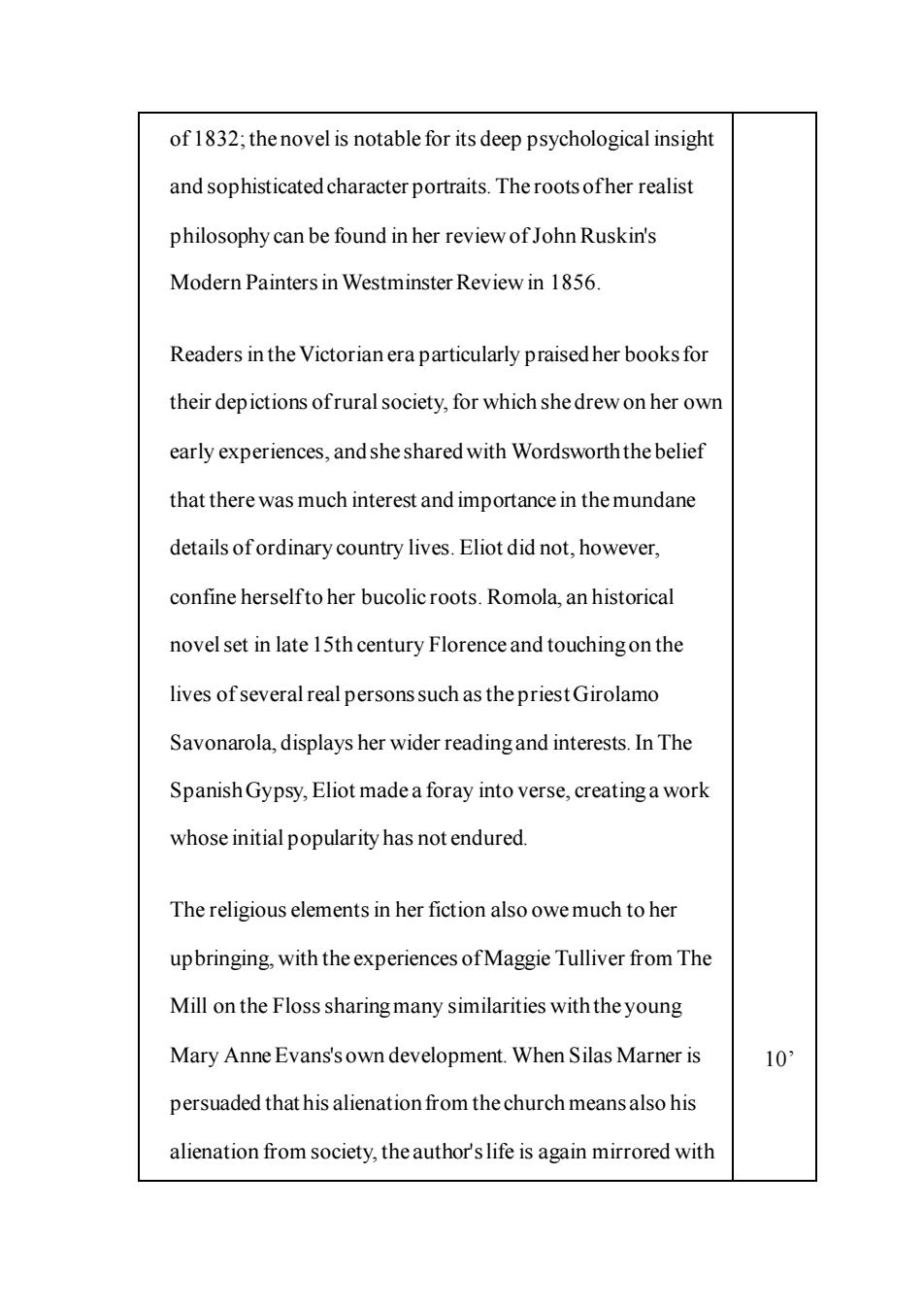
of 1832:thenovel is notable for its deep psychological insight and sophisticated character portraits.Theroots ofher realist philosophy can be found in her review of John Ruskin's Modern Painters in Westminster Review in 1856 Readers in the Victorian era particularly praised her books for their depictions ofrural society.for which she drew on her own early experiences,and she shared with Wordsworththe belief that there was much interest and importance in the mundane details ofordinary country lives.Eliot did not,however, confine herselfto her bucolic roots.Romola,an historical novel set in late 15th century Florence and touchingon the lives of several real persons such as the priest Girolamo Savonarola,displays her wider readingand interests.In The Spanish Gypsy,Eliot made a foray into verse,creatinga work whose initial popularity has not endured. The religious elements in her fiction also owe much to her upbringing,with the experiences of Maggie Tulliver from The Mill on the Floss sharing many similarities withthe young Mary Anne Evans's own development.When Silas Marner is o. persuaded that his alienation from the church meansalso his alienation from society,the author's life is again mirrored with
of 1832; the novel is notable for its deep psychological insight and sophisticated character portraits. The roots of her realist philosophy can be found in her review of John Ruskin's Modern Painters in Westminster Review in 1856. Readers in the Victorian era particularly praised her books for their depictions of rural society, for which she drew on her own early experiences, and she shared with Wordsworth the belief that there was much interest and importance in the mundane details of ordinary country lives. Eliot did not, however, confine herself to her bucolic roots. Romola, an historical novel set in late 15th century Florence and touching on the lives of several real persons such as the priest Girolamo Savonarola, displays her wider reading and interests. In The Spanish Gypsy, Eliot made a foray into verse, creating a work whose initial popularity has not endured. The religious elements in her fiction also owe much to her upbringing, with the experiences of Maggie Tulliver from The Mill on the Floss sharing many similarities with the young Mary Anne Evans's own development. When Silas Marner is persuaded that his alienation from the church means also his alienation from society, the author's life is again mirrored with 10’
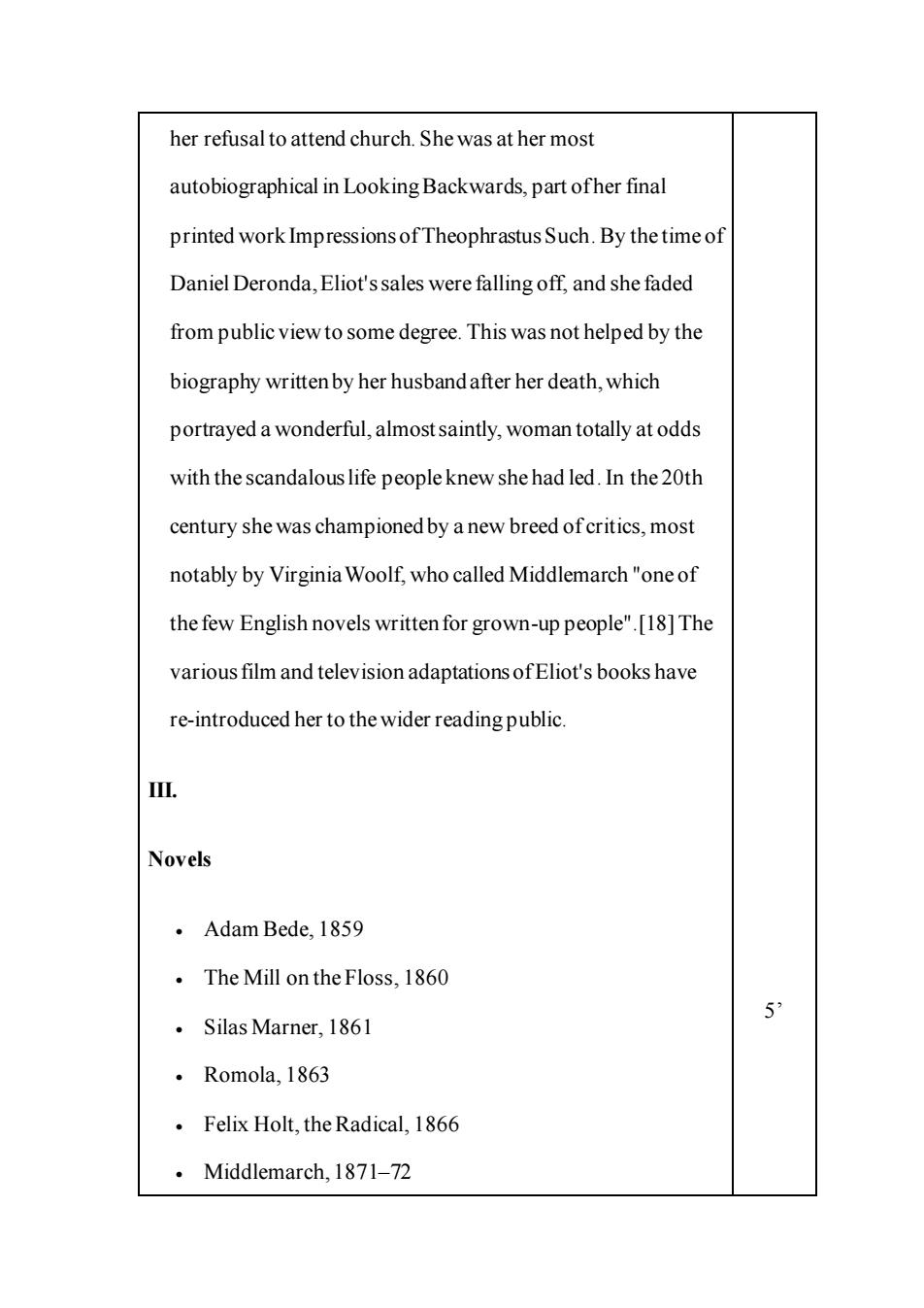
her refusal to attend church.She was at her most autobiographical in Looking Backwards,part ofher final printed work Impressions of Theophrastus Such.By the time of Daniel Deronda,Eliot'ssales were falling off,and she faded from public view to some degree.This was not helped by the biography writtenby her husband after her death,which portrayed a wonderful,almostsaintly,woman totally at odds with the scandalous life people knew she had led.In the 20th century she was championed by a new breed ofcritics,most notably by Virginia Woolf,who called Middlemarch "one of the few English novels written for grown-up people".[18]The various film and television adaptations ofEliot's books have re-introduced her to the wider reading public. II. Novels ·Adam Bede,.1859 The Mill on the Floss,1860 5 Silas Marner,1861 ·Romola,1863 Felix Holt,the Radical,1866 Middlemarch,1871-72
her refusal to attend church. She was at her most autobiographical in Looking Backwards, part of her final printed work Impressions of Theophrastus Such. By the time of Daniel Deronda, Eliot's sales were falling off, and she faded from public view to some degree. This was not helped by the biography written by her husband after her death, which portrayed a wonderful, almost saintly, woman totally at odds with the scandalous life people knew she had led. In the 20th century she was championed by a new breed of critics, most notably by Virginia Woolf, who called Middlemarch "one of the few English novels written for grown-up people".[18]The various film and television adaptations of Eliot's books have re-introduced her to the wider reading public. III. Novels • Adam Bede, 1859 • The Mill on the Floss, 1860 • Silas Marner, 1861 • Romola, 1863 • Felix Holt, the Radical, 1866 • Middlemarch, 1871–72 5’
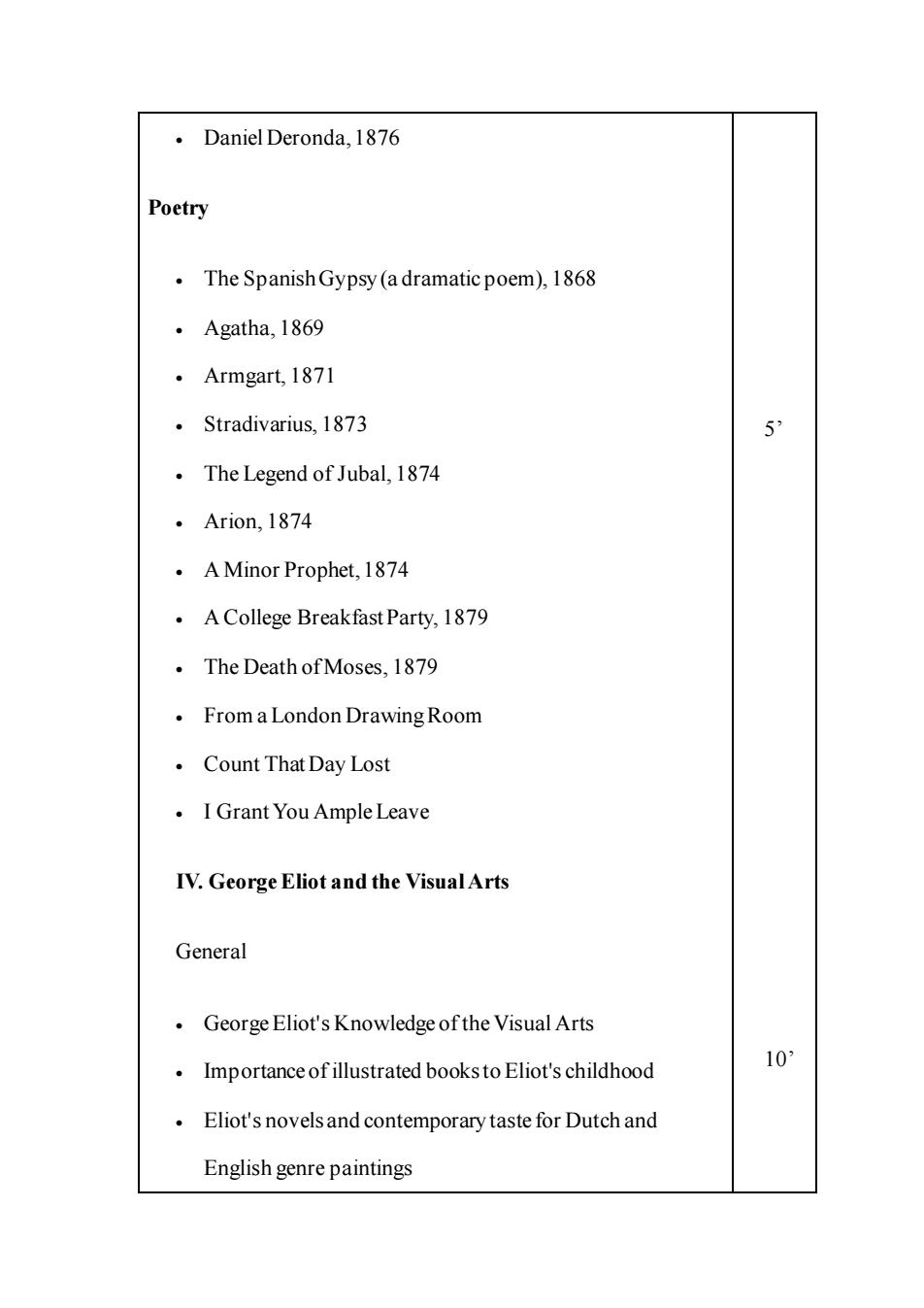
·Daniel Deronda,l876 Poetry The Spanish Gypsy(a dramatic poem),1868 Agatha,1869 。 Armgart,1871 。 Stradivarius.1873 5 The Legend of Jubal,1874 ·Arion,.1874 ·A Minor Prophet,.1874 。 A College Breakfast Party,1879 The Death of Moses,1879 From a London Drawing Room ·Count That Day Lost I Grant You Ample Leave IV.George Eliot and the Visual Arts General George Eliot's Knowledge of the Visual Arts Importance of illustrated books to Eliot's childhood 0, Eliot's novels and contemporary taste for Dutch and English genre paintings
• Daniel Deronda, 1876 Poetry • The Spanish Gypsy (a dramatic poem), 1868 • Agatha, 1869 • Armgart, 1871 • Stradivarius, 1873 • The Legend of Jubal, 1874 • Arion, 1874 • A Minor Prophet, 1874 • A College Breakfast Party, 1879 • The Death of Moses, 1879 • From a London Drawing Room • Count That Day Lost • I Grant You Ample Leave IV. George Eliot and the Visual Arts General • George Eliot's Knowledge of the Visual Arts • Importance of illustrated books to Eliot's childhood • Eliot's novels and contemporary taste for Dutch and English genre paintings 5’ 10’